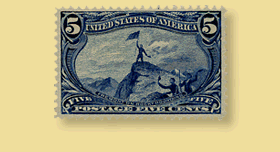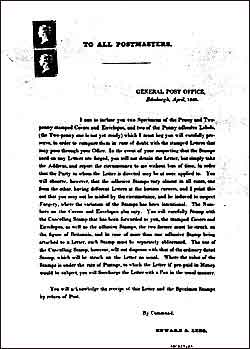 |
 |
 |
 |
||||||||||||||||||||||||
Educational Resources > Research Articles > The Philatelic Foundation ArchivesThe British Penny Black(with Particular Emphasis on the Removal of Cancellations)Philatelic Foundation Analysis Leaflet from May, 1984 From the very first postal issue, the removal of cancellations has been a cause of some consternation and considerable monetary loss to postal officials as well as to collectors. That first issue, the Penny Black of Great Britain, is the subject of this Analysis Leaflet, but much of what is stated is equally applicable to other issues.
Although the possibility of removed cancellations is not discussed in the general letter sent to all Postmasters (reproduced at left), the subject was nonetheless on the minds of Post Office officials. In his diary for April 24th, 1840, Rowland Hill notes, "Wrote to Maberly" (Secretary of the Post Office) "to call his attention to the power of Creosote to wash out the Post Office Stamp, and enclosed a specimen of red ink by Perkins and Co. (Editor's note: printers of the Penny Black, actual name Perkins, Bacon & Co.), which is free from this objection." (Endnote 1) Hill's optimism was short-lived, as it was soon discovered that the red "Maltese Cross" cancellations could in fact be cleaned off. Early official experiments with canceling inks and the possibilities of removing them chemically came at the end of May 1840. On June 27th we find Rowland Hill writing, "All who have professed to be able to remove the red ink obliteration have been requested to try their hands on the black ink, and have given it up." Then a significant statement: "I shall prepare a report on the subject of obliteration, and propose to adapt (sic) a light colour for the penny stamps." (Endnote 1) Obviously, Hill's thinking was that if the black canceling ink were to be adopted, the color of the stamp would have to be changed. "Black on black" would not do. This thought process becomes clearer on July 21st, when Hill writes, "Mr. Donovan, a chemist of Dublin has succeeded in removing not only the red, but the black ink obliterating stamp...we are therefore at sea again." All sorts of canceling inks were tested, at times with amusing results. We find comments from Hill such as, "Watson's ink will not do, it resists all attempts to remove it, but, unfortunately, it in time destroys the paper..." and, about an ink to which a volatile oil had to be added, "...they cannot bear the smell at the P.O." (Endnote l) As many philatelists know, eventually a decision was made to replace the world's first stamp - the One Penny Black - with a One Penny Red Brown, issued in 1841. The point in all of this is that if some individuals could not resist the temptation of removing cancellations for the sake of saving one penny's postage in 1840, does it not become even more tempting for stamp "doctors" to attempt to turn a used stamp into one that appears to be a much more valuable unused variety? Can philatelists really protect themselves from purchasing such material? Even the experts are challenged by unused British Penny Blacks. The aging process alone will tend to take its toll on any marking. Fortunately, although aging and stamp doctors continue to work on cancellations, there are ways in which the buyer of a stamp can take precautions. Given the natural tendency to give much closer attention to a stamp in direct relation to its increasing value, experts have refined their techniques for examination for possible removed cancellations. Continuing to use the British Penny Black and its replacement 'Penny Red' as examples, The Philatelic Foundation has received sufficient copies of each to show a pattern. The results of our findings for all stamps submitted to date (not including copies on cover) are as follows:
The findings on the Penny Black are self-evident. Fully 20% of all stamps submitted have been found to have undergone attempts to remove the cancellations. Going further, if we exclude from the total submissions above those Penny Blacks (27) that were submitted as used (for expertizing as to condition, plate varieties, etc.), then the 16 stamps that underwent cancellation removals constitute almost 30% of all stamps submitted. On the other hand, although the sample size is much smaller and the value differential much less, it is still revealing that not one Penny Red submission was found to have undergone removal of a cancellation. Checking for Removed CancellationsWhat methods can the philatelist use to determine if a stamp might have had a cancellation removed? Although we should caution collectors and dealers that these tests are not always conclusive and that expert opinion may be needed at times, there are some considerations to keep in mind, as follows:
As noted, these methods may or may not be conclusive. The British Penny Black was the first stamp subjected to attempts to remove cancellations, but it has by no means been the last. If the philatelist has any doubts and if the used/unused value differential is significant, submission to an expertizing service such as that provided by The Philatelic Foundation is advisable. Endnote:
|
||||||||||||||||||||||||
The Philatelic Foundation is located at 341 West 38th Street, 5th Floor, New York, NY 10018 Copyright 2005 - by The Philatelic Foundation, all rights reserved.
|
||||||||||||||||||||||||
| Home | What's New | Expertizing | Why Expertize? | History | Educational Resources Publications | Who's Who | Become a Contributor | Contact The PF Application for a Certificate |
||||||||||||||||||||||||
